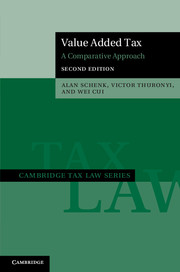Book contents
- Frontmatter
- Dedication
- Contents
- List of Tables and Charts
- List of Cases
- Preface to the Second Edition
- 1 Introduction
- 2 Consumption Tax Forms and Base Alterations
- 3 Varieties of VAT in Use
- 4 Registration, Taxpayer, and Taxable Activity
- 5 Taxable Supplies and Tax Invoices
- 6 The Tax Credit Mechanism
- 7 Introduction to Cross-Border Aspects of VAT
- 8 Timing and Valuation Rules
- 9 Zero-Rating, Exemptions, and Exempt Entities
- 10 VAT Evasion and Avoidance
- 11 Gambling and Financial Services (Other than Insurance)
- 12 Insurance
- 13 Real Property
- 14 An Anatomy of the Chinese VAT
- 15 Interjurisdictional Aspects
- Appendix VATs Worldwide
- Index
- References
1 - Introduction
Published online by Cambridge University Press: 05 February 2015
- Frontmatter
- Dedication
- Contents
- List of Tables and Charts
- List of Cases
- Preface to the Second Edition
- 1 Introduction
- 2 Consumption Tax Forms and Base Alterations
- 3 Varieties of VAT in Use
- 4 Registration, Taxpayer, and Taxable Activity
- 5 Taxable Supplies and Tax Invoices
- 6 The Tax Credit Mechanism
- 7 Introduction to Cross-Border Aspects of VAT
- 8 Timing and Valuation Rules
- 9 Zero-Rating, Exemptions, and Exempt Entities
- 10 VAT Evasion and Avoidance
- 11 Gambling and Financial Services (Other than Insurance)
- 12 Insurance
- 13 Real Property
- 14 An Anatomy of the Chinese VAT
- 15 Interjurisdictional Aspects
- Appendix VATs Worldwide
- Index
- References
Summary
Scope of Book
The value added tax (VAT) has spread around the world more quickly than any other new tax in modern history. This book covers value added tax and, in some parts, other consumption taxes in use or proposed in developing and developed countries.
Tax on consumption generally refers to a tax on final consumption, consisting mainly of goods and services acquired by individuals for their personal use or satisfaction. It generally does not include business inputs (goods and services used by business in the production or distribution of goods or in the rendition of services).
It is difficult for a business to operate internationally without considering the implications of sales tax or value added tax, whether or not the company’s country of residence has a broad-based tax on consumption. For example, the United States does not have a sales tax or value added tax, except at the state and local levels of government. Nevertheless, a U.S. business operating in, shipping goods or transferring intellectual property or providing or receiving services to and from other countries must consider the VAT implications of exports to or imports from those countries.
This book explores value added and other consumption tax principles from a comparative perspective. We hope that this study may lead to suggestions for improving existing VAT systems and designing new ones. We discuss VAT in the Member States of the European Union (EU), and explain major departures from the EU model in non-European countries (especially in New Zealand, China, Japan, and South Africa).
- Type
- Chapter
- Information
- Value Added TaxA Comparative Approach, pp. 1 - 19Publisher: Cambridge University PressPrint publication year: 2015



